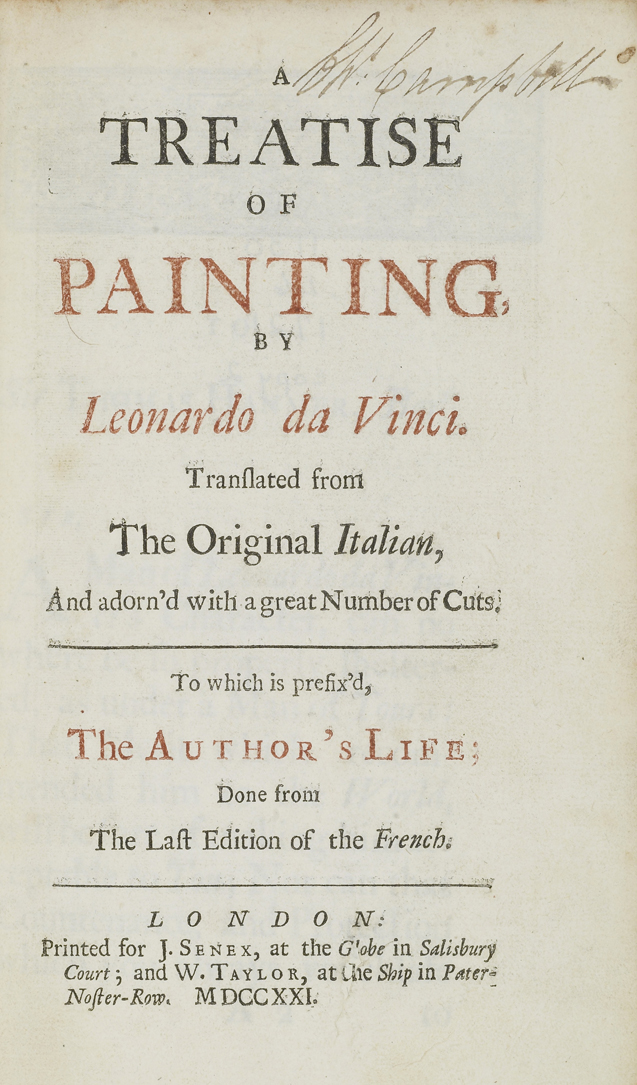
A Treatise on Painting, by Leonardo da Vinci
1721
Senex and Taylor, London
Chapter Display  |
|
In the first place you must Paint the Smoke of Artillery, confusedly mingled in the Air, with the Dust arising from the Horses Feet. In expressing this mixture observe the following Rules. Tho' Dust, by reason of its extreme lightness, does easily mount into the Air, yet has it the common affection of all natural Bodies, I mean Gravity, by which it returns of it self towards the Earth; none but the finest and most subtle Parts of it continuing to float in the Air: it must be Painted therefore of a very thin weak Colour, and not much unlike to that of Air; the Smoke which mingles it self with the Air and Dust, being mounted to a certain Pitch, will appear like dark Clouds; in the more elevated Parts, it will be much more visible than the Dust, and will appear of a Colour somewhat Azure and Blueish; the Dust always retaining its natural Colour.* This mixture of Air, Dust, and Smoke, will appear much brighter on the side whence the Light comes, than on the opposite one. The deeper the Combatants are sunk in this Cloud, the less visible they will be, and the less difference there will be between their Lights and Shadows. The Faces, Persons, Airs, Arms, and every thing about them, must be Painted of a Fiery Red Colour, this Redness always diminishing as it is further removed from its Origin, and at last losing it self intirely. The Figures far distant, between you and the Light, must appear dark, upon a light Ground, their Legs being always the least distinct and visible; because the nearer the Earth, the thicker and grosser is the Dust. If you represent any Horsemen out of the main Battle, remember to raise a little Cloud of Dust behind each of them, at the distance of each stretch of the Horse; taking care that they weaken and disappear, as they become further removed from the Horse that rais'd them; and observing that those which are the farthest distant, be the highest, spread the widest, and the thinnest; and those nearer the lowest, densest, and most sensible. The Air must appear full of trains of Fire, darting like Lightning, some upwards some down, and others in a level with the Earth. The Balls discharged from Fire Arms, must leave a train of Smoke behind them; and the Front Figures must appear cover'd with Dust; especially their Eye-brows, and other Parts apt to retain it: The Conquerors must be represented running, with their Hair scatter'd abroad, and both that, and their Draperies blown about by the Wind; their Faces frowning, their Eyebrows swell'd, and drawn near one another; their Members must make a*Contrast a mong them, so that if the right Foot step the foremost, the left Arm must be advanced the furthest. If you represent any one fallen, let the Blood trickling from his Wound, stain the Dust; and let the wet Earth all around be mark'd with the Footsteps of Men and Horses: You may likewise Paint the Figures of Horses, dragging and tearing their dead Masters hanging in the Stirrups, and smearing the Ground they pass over with Blood: The vanquish'd must appear pale, and astonished, their Eye-brows high, their Foreheads full of wrinkles, their Nostrils shrunk into an Arch, and furrow'd from the tip of the Nose, to the Eyes; their Mouths gaping, their Lips turn'd back, discovering the Teeth unclench'd, and in a Posture of shrieking and lamentation. Let some one lying wounded on the Ground, with terror and amazement in his looks, hold one Hand before his Eyes, the Palm towards the Enemy; with the other fix'd on the Earth, supporting his Body: You may show some turning their Backs, and flying with open Mouths: the Field of Battle must be covered with Arms of all sorts, trampled under Foot by the Combatants; shatter'd Helms, Bucklers, broken Swords, shiver'd Lances, and the like: Among the Slain may appear some half covered with Dust, and broken Weapons; others as it were quite buried under them: Streams of Blood must be seen Issuing from the wounded, and flowing into the Dust; and this mixture of Blood and Dust, must cover the Earth with a Purple Mire. Some may be represented in the Pangs of Death, grinding their Teeth, rolling their Eyes, clenching their Fists, and making several Contorsions of Body, Arms, and Legs: another may be seen disarmed, and thrown down by his Enemy, yet still defending himself with his Teeth and Nails. A Horse may be shown broken loose, and running through the Enemy, with his Main dispers'd, and floating in the Wind, beating down all he meets with: Some one wounded, may be seen tumbling to the Ground, and covering himself with his Buckler; his Antagonist at the same time stooping over him to take away his Life: There may be likewise represented a whole croud of Men, confusedly spread under a dead Horse: Some of the Conquerors may be shown retiring out of Battle, wiping their Eyes clamm'd up with Dust, and their Cheeks smear'd with Filth, form'd out of Sweat and Tears which the Dust had made to trickle from their Eyes: You may likewise represent Squadrons advancing to succour their Fellows, full of hope, mix'd with circumspection; their Eye-brows drawn up on high, shadowing their Faces with their Hands, the better to discern the Enemy through the Dust, and attentively waiting the commands of their Leader. The General must be seen with his Truncheon in his Hand, ranging his Troops, and pointing out, what way each Battalion is to move: A River may be represented, and Horsemen seen plunging through it, dashing the Water all around them, and raising a Froth where ever they pass. Nothing in fine must be seen throughout the whole Field of Battle, but what is full of Horror, Blood, and Carnage.
* The Authors Words are, dalla parte che viene il Lume parrà questa Mistione d' Aria, fumo, & Polvere, molto più lucida che dalla opposita parte. Which the French Translator has taken the Liberty to alter, turning them thus, de Melange d'Air, de Fumee, & de Poussiere, sera beaucoup plus clair sur le baut que vers le bas, i. e. This mixture of Air, Smoke and Dust, will be much clearer at the top, than towards the bottom. One of these two Meanings, we hope, cannot fail to please the Reader.
* Contrast, signifies Quarrel or Opposition; and is used to denote the different. Aspects, and Positions, either of the Parts of a Figure, as in the Place here refer'd to; or of the Figures forming a Group or Assemblage; as for instance, when one Figure shows it self side-ways, another full before you, a third on the other side, &c. they make a Contrast.